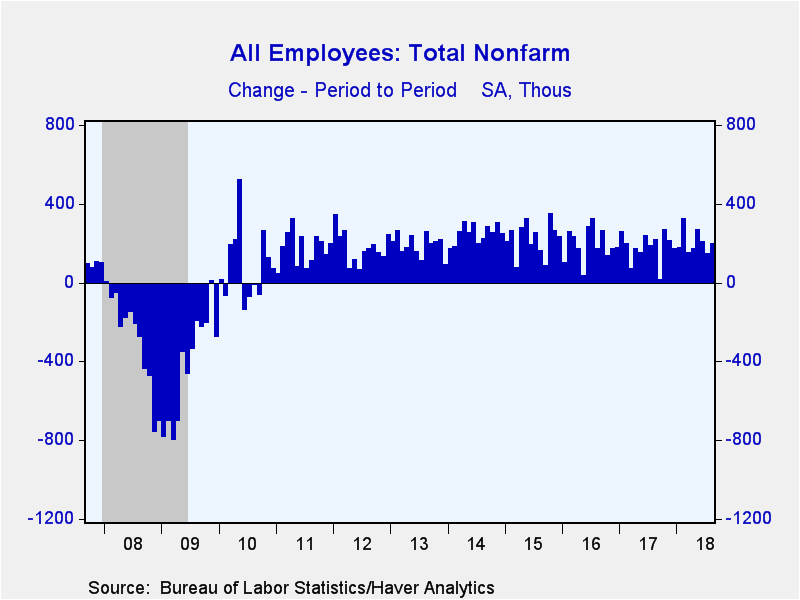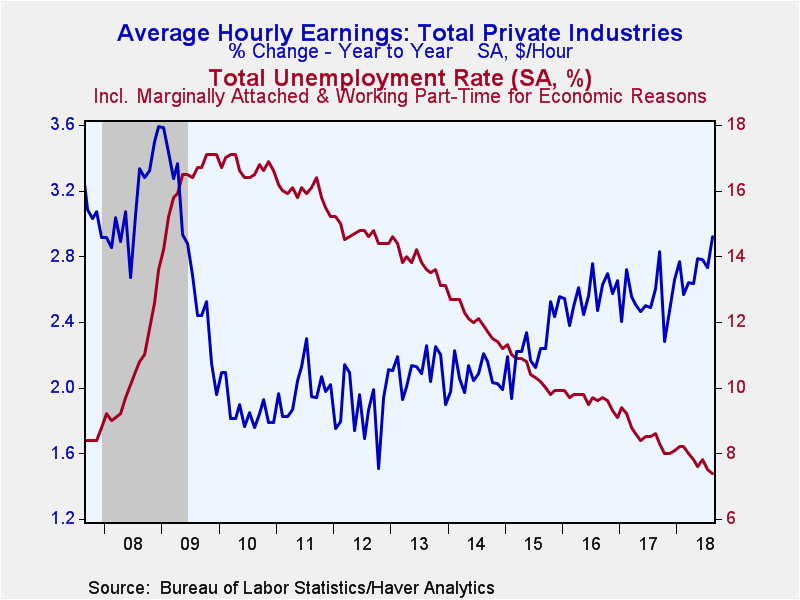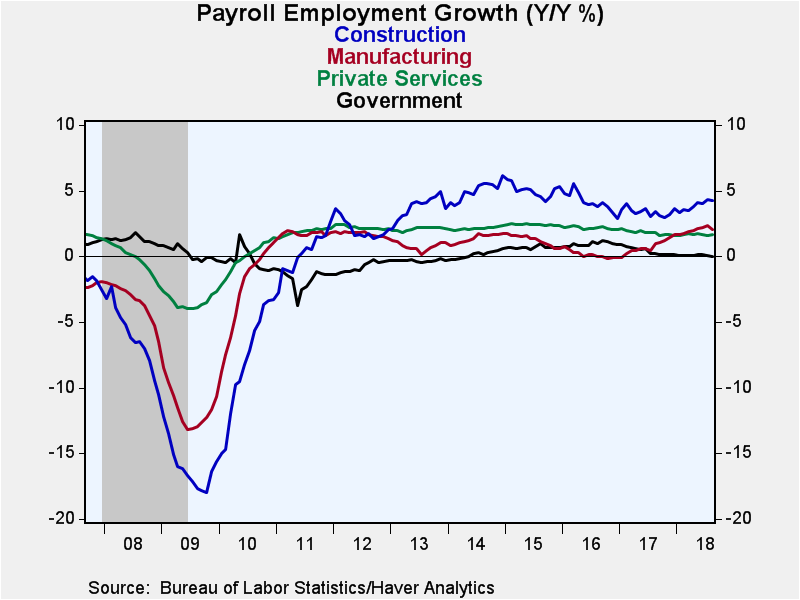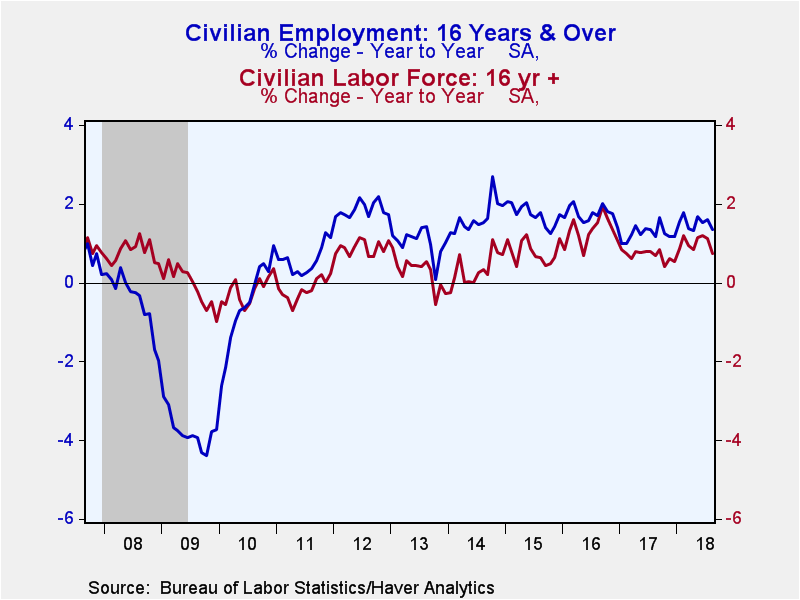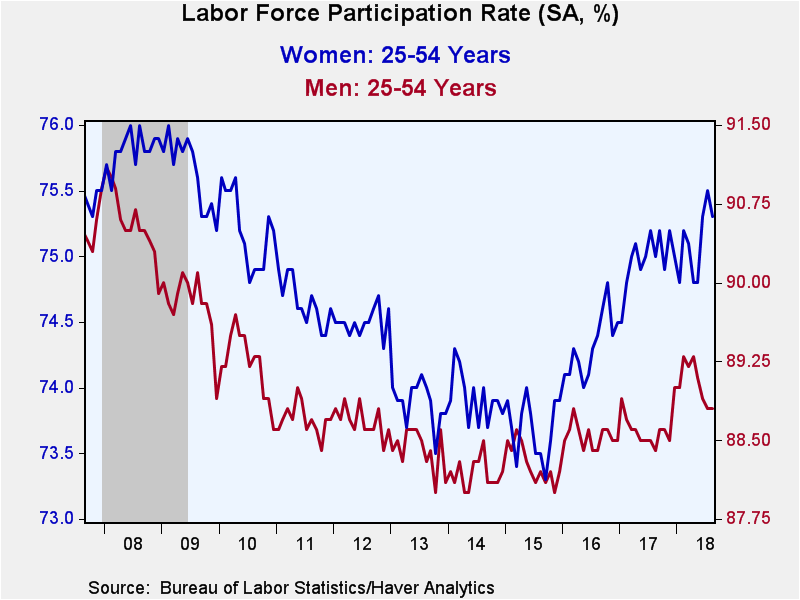 Global| Sep 07 2018
Global| Sep 07 2018U.S. Nonfarm Payroll Employment and Wage Growth Pick Up; Jobless Rate Steadies
by:Tom Moeller
|in:Economy in Brief
Summary
The labor market firmed last month. Nonfarm payrolls increased by 201,000 (1.6% y/y) during August following a 147,000 July rise, which was revised down from 157,000 estimated last month. The gain in June payrolls also was lessened to [...]
The labor market firmed last month. Nonfarm payrolls increased by 201,000 (1.6% y/y) during August following a 147,000 July rise, which was revised down from 157,000 estimated last month. The gain in June payrolls also was lessened to 208,000 from 248,000. A 190,000 rise in August employment had been expected in the Action Economics Forecast Survey.
The y/y increase in average hourly earnings during August rose to 2.9%, the strongest gain since June 2009. On a monthly basis, wages increased 0.4% following an unrevised 0.3% July gain. June's rise was strengthened, however, to 0.2% from 0.1%. A 0.2% increase in August wages had been anticipated.
The unemployment rate remained at 3.9%. A dip to 3.8% had been expected. The total unemployment rate, including those marginally attached and working part-time for economic reasons, fell to 7.4%, the lowest level since April 2001.
From the payroll employment survey, the 201,000 job increase reflected strength in service sector hiring which rose 178,000 (1.6% y/y), its strongest gain in three months. Professional & business services hiring increased a strengthened 53,000 (2.5% y/y) as the number of temporary-help jobs rose 10,000 (2.9% y/y). The number of education & health services jobs also grew 53,000 (1.9% y/y) while leisure & hospitality employment rose 17,000 (1.6% y/y). Trade, transportation & utilities employment increased 37,000 (1.2% y/y) and financial sector jobs improved 11,000 (1.3% y/y).
In the government sector, employment declined 3,000, down for the second straight month. It was unchanged y/y. Federal government jobs held steady (-0.2% y/y) and state government employment eased 1,000 (-0.6% y/y) for a second straight month. Hiring by local government fell 2,000 (+0.3% y/y).
Average hourly earnings strengthened 0.4% as private-sector services pay also increased 0.4%. The 3.0% y/y gain set the cycle's high. Financial activities earnings rose an accelerated 4.7% y/y but information sector pay rose a lessened 3.4% y/y. Leisure & hospitality earnings grew a diminished 3.2% y/y, but education & health services earnings gained an improved 2.6% y/y. Construction sector pay grew a fairly steady 3.3% y/y while factory sector earnings rose a diminished 1.8% y/y.
The length of the average workweek held steady m/m at 34.5 hours, though that was down from the cycle peak of 34.6 hours. Financial activities hours rose to 37.6 but professional & business services hours eased to 36.1. Information sector hours held at 36.1 but education & health services hours rose to 33.0. Leisure & hospitality hours were unchanged at 26.1. The length of the factory sector workweek held steady at 41.0 hours but construction sector hours eased to 39.3.
From the household employment survey, the unchanged unemployment rate of 3.9% reflected a 423,000 decline in employment and a 469,000 drop in the labor force. The labor force participation rate eased to 62.7%, its lowest level in three months. The labor force participation rate for men aged 25-54 held steady at 88.8% and for women aged 25-54 it eased to 75.3%. The average duration of unemployment eased to 22.6 weeks.
By educational attainment, unemployment for individuals with less than a high school diploma was 5.7% and for high school graduates, but no college, it was 3.9%. Those with less than a bachelors degree were 3.5% unemployed and college graduates were 2.1% without work.
The teenage unemployment rate eased to 12.8% while individuals aged 20-24 years were 6.8% without work. The unemployment rate for those aged 25-54 was 3.2% and persons aged 55 and over were 3.1% unemployed.
The labor market data are contained in Haver's USECON database. Detailed figures are in the EMPL and LABOR databases. The expectations figures are in the AS1REPNA database.
| Employment: (SA, M/M Change, 000s) | Aug | Jul | Jun | Aug Y/Y | 2017 | 2016 | 2015 |
|---|---|---|---|---|---|---|---|
| Payroll Employment | 201 | 147 | 208 | 1.6% | 1.6% | 1.8% | 2.1% |
| Previous Estimate | -- | 157 | 248 | -- | -- | -- | -- |
| Manufacturing | -3 | 18 | 21 | 2.0 | 0.7 | 0.1 | 1.2 |
| Construction | 23 | 18 | 8 | 4.3 | 3.4 | 4.1 | 5.0 |
| Private Service-Producing | 178 | 117 | 156 | 1.6 | 1.8 | 2.2 | 2.4 |
| Government | -3 | -6 | 16 | 0.0 | 0.4 | 0.9 | 0.7 |
| Average Weekly Hours - Private Sector | 34.5 | 34.5 | 34.6 | 34.4 | 34.4 | 34.4 | 34.5 |
| Private Sector Average Hourly Earnings (%) | 0.4 | 0.3 | 0.2 | 2.9 | 2.5 | 2.6 | 2.3 |
| Unemployment Rate (%) | 3.9 | 3.9 | 4.0 | 4.3 | 4.4 | 4.9 | 5.3 |
Tom Moeller
AuthorMore in Author Profile »Prior to joining Haver Analytics in 2000, Mr. Moeller worked as the Economist at Chancellor Capital Management from 1985 to 1999. There, he developed comprehensive economic forecasts and interpreted economic data for equity and fixed income portfolio managers. Also at Chancellor, Mr. Moeller worked as an equity analyst and was responsible for researching and rating companies in the economically sensitive automobile and housing industries for investment in Chancellor’s equity portfolio. Prior to joining Chancellor, Mr. Moeller was an Economist at Citibank from 1979 to 1984. He also analyzed pricing behavior in the metals industry for the Council on Wage and Price Stability in Washington, D.C. In 1999, Mr. Moeller received the award for most accurate forecast from the Forecasters' Club of New York. From 1990 to 1992 he was President of the New York Association for Business Economists. Mr. Moeller earned an M.B.A. in Finance from Fordham University, where he graduated in 1987. He holds a Bachelor of Arts in Economics from George Washington University.


